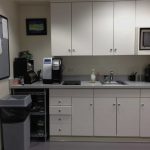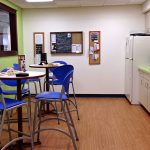by Sheila Selby

Before: This kitchen was a small, drab, uninviting room, with no place to sit. Employees used the room only to store or prepare their food.
When you throw a party at home, the kitchen is the place where everyone congregates. And these days, the office kitchen, or break

After: This workplace kitchen was enlarged during an office renovation. Bright colors, high-top tables, a wood-look vinyl floor, and windows to the hall make this space welcoming. Employees now use this break room for eating, socializing, and collaboration.
room, is the space in the workplace where coworkers like to spend time together. Just like the kitchen is the heart of the home, the kitchen has become the heart of the workplace.
It’s interesting how the workplace kitchen has followed suit with the kitchens in our homes. Many older houses were built with a distinct kitchen, where food was prepared and meals eaten. Newer houses are often built with great rooms: spaces where a kitchen is open to a family living room.
Kitchens in offices used to be small rooms without any personality. They provided one function: a place to store your lunch. (If you were lucky, your break room had a table to eat at.)
Today, the traditional boundaries of working and playing are fading away in workspaces. The workplace kitchen is a space for employees to mingle, relax, and have fun. The socialization that occurs in the break room is ideal for encouraging employee collaboration, strengthening corporate culture, and enhancing employee morale.
What’s brought on this change in the workplace kitchen?
My thought is it’s because the Gen Xers and Millennials grew up in homes with great rooms and are used to the blend of play and work. This melding of space and activities continues when they’re in college. As the proportion of Xers and Millennials grows in the workforce, they’re requiring these multifunctional spaces to feel at home.
The current design elements are similar in both traditional offices, where kitchens are separate rooms, and in open plan workplaces, where the lines between break room and workspace are blurred. You’re likely to see a bright, welcoming area with comfortable lounge seating, a counter-height bar and stools instead of, or in addition to, tables, and a TV. If the area is large enough, there’s often a game table. The workplace kitchen is mimicking your great room at home.
It’s also interesting to note that many of the break rooms in today’s workplaces are virtually interchangeable with the rec rooms in college residence halls.
If you’re moving into new workspace or renovating your existing space, here are a few design ideas to create a break room of today:
- Locate the kitchen in a primary circulation path of all employees.
- Make the space as large as possible to accommodate multiple functions.
- Use home-like finishes, such as vinyl plank flooring resembling hardwood floors.
A company’s workspace design is a huge selling point for new hires. Research shows that after compensation and benefits, the physical workspace is the third most important factor in a prospective employee’s decision about joining a company.
Investing in the creation of an inviting, multifunctional workplace kitchen is an excellent use of a business’ resources. Having a wonderful heart pays off.
Sheila Selby is the founder/owner of On The Move Interiors, a commercial interior design and workplace strategy firm based in Brookline, Mass. She is also the workplace design strategic advisor for NorthBridge CRE Advisors and other firms.











